text bySAITO Makoto (Senshu University)
Hyperthermia refers to an acute condition resulting from excessive exposure to heat. There are different categories of hyperthermia such as heat syncope, heat exhaustion, heat stroke, and heat cramps. Hyperthermia is an extremely dangerous internal illness which, in serious cases, can even result in death. Examples of death induced by hyperthermia can be seen particularly in outdoor sports where players spend many hours outside practicing under the sun such as baseball, soccer and track and field. However, it is an unfortunate fact that the highest instances of hyperthermia seen in indoor sports occur in kendo. There were five cases of hyperthermia resulting in death among kendo practitioners between 1975 and 1997. In recent years, there have been hundreds of cases reported annually concerning kendo practitioners who have been admitted to hospitals for treatment of hyperthermia, although fortunately these did not result in death.
Recent Kendo Accidents
In recent years introducing preventative measures for hyperthermia has clearly become the responsibility of individual instructors. On August 30, 2002, a school teacher in charge of instructing kendo was discharged from his position as he was deemed “responsible for not taking adequate measures to treat a student who had succumbed to hyperthermia during club training, and died as a result.” When this accident occurred, the only treatment administered by the instructor was to place the student under a fan, and an ambulance was not called for another two hours. It is commonly accepted that harsh training regimes are an integral characteristic of kendo. That being the case, however, it stands to reason that adequate risk management should also be considered in the event of an emergency during training. Unfortunately, even though kendo has the highest rate of hyperthermia of all indoor sports in Japan and related information is readily available, in actuality it is rarely acted upon.
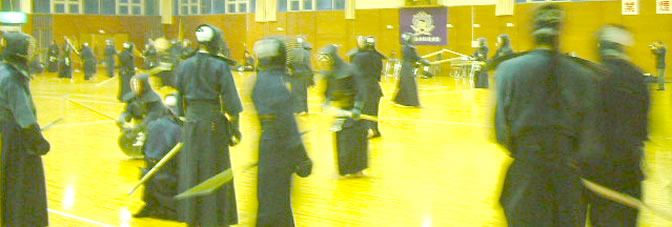
Why hyperthermia easily occurs in kendo
Hyperthermia can be divided into the categories of heat syncope, heat exhaustion, heat cramps, and heat stroke. There are two causes for hyperthermia:
(1) An acute increase in body temperature through physical exertion in a hot environment.
(2) Loss of body fluids and salt through sweat.
There are characteristics of kendo training which accentuate these 2 causes.
Characteristics which accentuate the risk of hyperthermia
1) The conscious implementation of special summer training
Firstly, summer training holds a special place in kendo, along with special winter training. Namely, trainees purposefully train in adverse conditions not so much to improve technique or stamina, but to strengthen their spirit or mind. To this purpose, students are often deliberately denied water for hydration during training. Indeed, it is conceivable that training in such a harsh environment does contribute to the development of a resilient mind. On the other hand though, it is also undeniable that such actions can be life threatening.
2) Keiko-gi (training top) and bogu (protective equipment) which retain body heat and impede hydration
Next, there is the problem of keiko-gi and bogu. According to one research report, if gokaku-keiko (sparring) is conducted for 1 hour in an environment where the temperature is 30℃ with 70% humidity, the trainee’s body weight may decrease from between 3.0% to 5.6%. This loss in body weight corresponds to the loss of sweat which means a loss of approximately 1.8 to 3.4 litres of sweat (one or two PET bottles). In another report, an experiment was conducted in which a subject pedalled a bicycle in hot conditions wearing full kendo equipment. Compared with a shirt and shorts, it was found that when the kendo equipment was worn the body temperature was on average 2℃ higher (maximum close to 40℃). Kendo wear and protective armour is purposefully manufactured thick and durable in order to offer protection from blows with the shinai (bamboo sword). However, this is not conducive to release of body heat and therefore is conversely quite dangerous. Also, as the men (facemask) covers the entire face this also impedes hydration.
3) Training configuration that inhibits hydration
Lastly, there is the problem of the configuration of training sessions. Typically a training session will be conducted with trainees lined up in 2 rows facing their partner. Basic drills are practiced in a logical regimen of pairs in accordance with the instructor’s commands. During training sessions, there is no time allotted to remove the men or step out of the training area. The continual practice of techniques, sparring, and other training patterns such as kakari-geiko (attack practice) and so on is considered an integral part of the beauty of kendo, and from an instructional perspective is very time-effective. However, the downside of this style of training is that if one person steps out their partner will also have to cease training. Therefore, it is difficult to drop out temporarily for a break, meaning little opportunity to hydrate even when the need is felt. Trainees feel obligated to continue training even if they are not feeling well, which is a cause of hyperthermia.
The connection between hydration and improved performance
Graph 1 compares the results of an experiment of people participating in athletic activity where one group hydrated and the other did not. The graph shows a change in heart rate. When fluids are not taken during exercise the pulse increases dramatically. Because the amount of blood in the body decreases (water in the blood is expelled from the body as sweat making the blood thick), this reduces the blood’s functional ability to supply oxygen and nutrients to muscles, hence resulting in an increased heart rate. Naturally, if oxygen and nutrients are not being delivered throughout the body, this is going to result in an adverse effect on overall athletic function and ability, and cognitive judgment will decrease. In other words, continuing to train without maintaining fluid intake will adversely affect athletic performance compared to when fluid intake is maintained. In this sense, fluid intake is not only necessary to prevent hyperthermia, but is also vital in maintaining a high level of athletic performance.
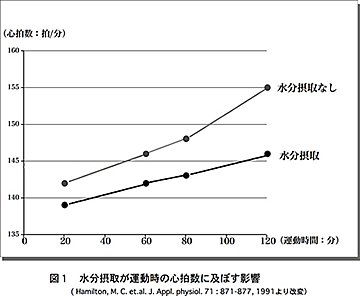
What preventative care can be taken? -Suitable environment-
What kind of care can be taken when training in a hot environment? Graph 2 is a guide for preventative measures against hyperthermia. Be sure to install a thermometer that can read humidity in the dojo. Japanese summers are extremely humid. Although this information is not included in the graph, there are some instructional manuals that recommend taking 250cc of water every 15 minutes. Taking this advice into consideration, it becomes clear how dangerous the conditions of customary kendo training really are. Furthermore, this information does not take into account the equipment worn while doing kendo, which means that even more care needs to be taken.
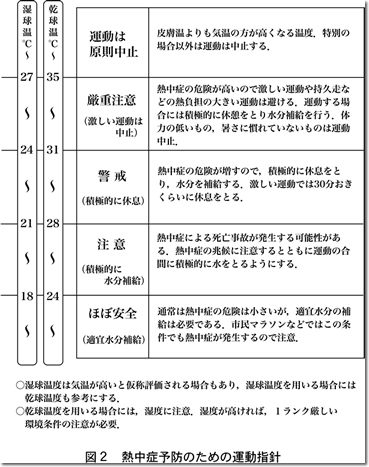
What kind of fluids should be consumed? -Amount, salt, temperature-
Fluid intake is an effective means of preventing hyperthermia. Drinking pure water does have some positive effects; however, it can also conversely be a cause of hyperthermia. For example, if one experiences calf muscle cramps while practicing in a hot training environment, this may well be heat cramp, and could be due to a decrease of sodium in the body. The concentration of sodium in the body decreases because athletes sweat and only drink water to hydrate. In other words, water intake can give rise to heat cramps. Although it is better to drink some water than none at all, in order to prevent hyperthermia it is crucial to include 0.1 to 0.2% salt content (1 to 2 g of salt per 100 ml of water). Sports drinks are useful because of their sodium content. However, if there is no time to prepare such beverages before training, it will suffice to swallow a pinch of salt when drinking water.
Furthermore, the water temperature is also a critical factor in preventing hyperthermia. Although different books will give differing information, it is generally accepted that if the water is between 5 and 15 degrees C, it will facilitate quick travel and absorption in the intestines. Also, cold water has the effect of cooling the body down from the inside. Therefore it is advisable to make some cold water available in a hot training environment.
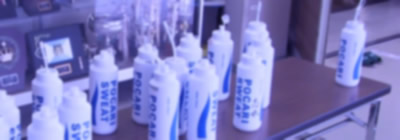
Treating hyperthermia
Regardless of what measures are taken to prevent hyperthermia, unfortunately there is always a risk that it will occur in the midst of a gruelling training session. As I mentioned in the introduction of this paper, an accident that is not dealt with appropriately will not only be the responsibility of the instructor, but far more importantly it may result in the tragic loss of life of a student. Kendo accidents that have the potential to result in death include shinai breakage, or a blow to the back of the head after falling over. However, the most representative examples of death caused through internal injuries stem from hyperthermia, and measures must be taken to minimalise this possibility.
Measures to be taken against hyperthermia are as follows:
1. Observation: When a student says they are feeling bad, appears to moving awkwardly, or falls over during training, the instructor should immediately try to establish symptoms by checking (a) consciousness (call their name, lightly tap them on the shoulder, and if they are responsive ask them a question which they should be able to answer easily) and (b) physical indications (consciousness, breathing, pulse, complexion, body temperature, and temperature of hands and feet).
2. Treatment: Immediately after observing the above, treatment must be administered in the following order: (a) Rest (remove bogu and loosen the ties on the keiko-gi.) (b) Cool down (rest the player in an air-conditioned room or somewhere with a breeze, but out of the sun). (c) Cool down 2 (massage the whole body with a cold towel and fan them. Apply an icepack under the armpits and on the thighs). (d) Supply fluids (if the person is completely conscious). Counter-measures for hyperthermia are introduced in Kendo Igaku Q&A (Kendo Medicine Q & A) published by the medical committee of the All Japan Kendo Federation. There are also many books and manuals which are easily available, including downloadable information on the homepage of the Japan Sports Association. I recommend that you read it before we head into the summer season.
Making rules for hydration
Currently it appears that there are few dojos or teams that actively hydrate during training. In school clubs, junior students are busy preparing for the next session or looking after their seniors, which leaves little time to hydrate during breaks. This makes it necessary to implement rules ensuring that students actively hydrate.
1) Lining up in file
Kendo training sessions are generally conducted with trainees lining up facing their partners and forming two lines, and then practicing set techniques in given time frames at the command of the instructor. Because of this typical training structure, if one student decides to take a break their partner is also forced to stop training. This makes it difficult for students to secure time during training to hydrate. However, this problem can be overcome when there is an odd number of practitioners. With odd numbers, there will always be one practitioner left waiting to rotate into the training, which is an opportunity to hydrate. Usually practitioners use this time to check their shinai and equipment. If there are 20 to 30 members training at once, such an opportunity will come once every 15 to 30 minutes. If the number of practitioners is an even number it can be managed by dividing the group into two groups. Whatever the case, rules can be put in place by which the player who is waiting to rotate into the file, or the end pair, are designated to stop training to hydrate.
2) Straws
Removing the men every time to hydrate in kendo is disruptive and lowers the efficiency of the training session. In order to reduce time loss, it is a good idea to drink through straws as they can be inserted through the grill of the men. If you are able to find drink bottles or cups with straws already inserted (such as those used in fast food stores) this will minimalise spillage.
3) Drinking rules
Even if instructors recognise that hydration is necessary to ensure high quality training sessions, it is often considered unseemly or a breach of etiquette to stand around drinking in the dojo. To counter this problem rules can be made in regards to how practitioners should drink while training. For example, it may me a simple matter of deciding where practitioners should drink (designating an area outside the dojo); squatting while drinking; or turning your back to the practicing members while drinking. Maintaining such etiquette is an important part of kendo that should always be continued.
Conclusion
The method of training, kendo wear and protective equipment, and training configuration are all important traditional aspects of kendo that have been developed over a long history, and as such should not simply be discarded. However, if deaths occur during training sessions, this will have an adverse effect on kendo tradition and how it is perceived. The idea “persevere in the heat and forge a strong mind” is compatible with the idea “the training will yield the best results if measures are included to counter the effects of the heat to ensure high quality training.” I hope that we hear no news of accidents occurring in kendo training this summer.

Copyright(C) Japanese Academy of Budo – All Rights Reserved.

